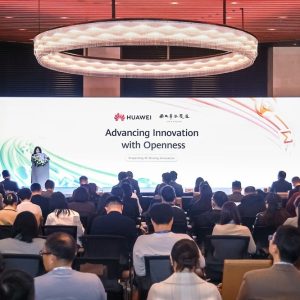
Microsoft will work with the US government Defense Advanced Research Projects Agency (Darpa) on ways to achieve utility-scale quantum computing. It is one of three companies selected as part of a program exploring non-mainstream quantum computing solutions. One analyst told Tech Monitor “big R&D partnerships will be key” to the long-term potential of quantum technology.

There are a multitude of approaches to quantum computing and it isn’t clear which, if any will prove to be dominant in the coming decades. The race is on to achieve sustainable, scalable fault tolerant processing to unlock computational tasks not possible or not viable with classical supercomputers.
Despite a handful of early use-cases in finance and pharmaceuticals, the technology is still in the early research and development stage where no single technology has become dominant, although two technologies are most commonly in use, namely trapped ion and superconducting qubits.
In a trapped-ion quantum processor, charged particles are suspended in free space and qubits are stored in the stable electronic states of each ion. This is popular among start-ups including Oxford Ionics, IonQ and Quantinuum due in part to the long qubit lifetime and the fact it is one of the more mature approaches to quantum computing.
The other major technology, used by some of the largest companies in the field including IBM, Google, D-Wave, IQM and even Microsoft itself is superconducting quantum computing. Under this approach superconducting circuits are used to perform quantum operations. It is one of the most mature forms of quantum computing and can provide more qubits than other types and require less energy.
Wide range of approaches to quantum computing
Outside of these two technologies, there are other approaches being developed by small and large companies including photonics, nuclear magnetic resonance, quantum annealing and topological quantum computing. The latter is a new focus for Microsoft and one area it will explore as part of its new Darpa partnership.
Two other companies are involved in the agreement, which is designed to explore ways that quantum technology can scale to a point where computational value exceeds its cost and does so much faster than conventional predictions. They are Atom and PsiQuantum.
Atom is building highly scalable quantum computers based on large arrays of optically-trapped atoms and PsiQuantum is using silicon-based photonics to create an error-corrected quantum computer based on a lattice-like fabric of photonic qubits.
Microsoft’s Azure Quantum team is building an industrial-scale quantum computer based on topological qubits. The company says this should, in theory, enable them to build a small enough machine to fit in a cabinet but fast enough to solve previously unsolvable problems in a practical timeframe with more than a million qubits.
“We are confident in this design given our significant physics breakthrough which cleared a major hurdle toward engineering the world’s first topological qubit and ultimately, a scaled quantum machine,” Microsoft engineers wrote in a blog post.
Rather than follow other quantum computing companies in having small, iterative updates with a handful of qubits at a time, Microsoft has focused on scale, basing its approach on the need for at least one million qubits to perform any useful calculations.
This is what inspired Darpa to partner with the company. As part of its Underexplored Systems for Utility-Scale Quantum Computing (US2QC) program, it is hoping to reduce the danger of a strategic surprise coming from an underexplored quantum approach.
“We put out a call last year saying that if anyone thought they had a truly revolutionary approach to building a useful quantum computer in the near future – less than ten years – we wanted to hear from them,” Joe Altepeter, US2QC program manager in Darpa’s Defense Sciences Office explained in a press release. “We offered to collaborate by funding additional experts to join their team and provide rigorous government verification and validation of their proposed solutions.”
Darpa targets US leadership in quantum computing
Darpa’s ultimate aim is to drive US commercial leadership in a strategically important technology area and for national security to avoid any big surprises if another country takes the lead in an area not being widely explored by the US.
The three companies will each present a design concept describing their plans for a utility-scale quantum computer which will get rigorous design focus on all systems and sub-systems and once it is constructed and tested Darpa’s test and validation team will evaluate the concept in more detail will move on to phase two that could see real-world implementation of the machines.
Ekaterina Almasque, general partner at venture capital company OpenOcean, an early investor in quantum computing start-up IQM, said quantum computing is a long-term play that relies heavily on government and Big Tech research budgets, including from far-thinking organisations that plant early seeds and nurture ecosystems.
“Darpa has a long history of breakthrough research, and their identification of scale as a key element of quantum computing is telling,” she says. “We are not in the era of quantum yet, but neither are we in the depths of a ‘quantum winter’ as some observers would suggest.
“Where we are is an exciting time of innovation where anything seems possible, a time when smaller start-ups have the opportunity to make breakthroughs, scale and compete with the work of tech giants like Microsoft.”
Need to focus on immediate use case
While quantum supremacy – the point at which quantum machines can outperform their classical counterparts – is still some time away, Almasque says she would expect to see a lot of progress over the next decade “although we may not see a fully functional quantum computer for some time”. Despite that, she predicts the technology will become commercially viable within five years.
“The Darpa/Microsoft focus on scale is reflective of each organisation’s style of thinking – they think on the macro-scale, and in decades rather than years,” she says. “It contrasts strongly with our own approach at OpenOcean and our portfolio company IQM. We backed IQM due to their application-specific but highly transformative proposition: to transform the world of high-performance computing with quantum.”
This approach has a lower hardware requirement, including on qubit count and gate depth, to achieve better performance than comparable high-performance classical computers. “We are already seeing the first use cases of quantum emerge: quantum-enhanced versions of existing processes,” Almasque says. “The journey to commercialisation is set in motion – and there’s no going back.”
She adds: “In the short term, progress will come with a focus on application-specific machines, designed for individual tasks. We should also remember that much of the energy right now in the quantum space is on software, building the software stack to connect real-world applications with the hardware. This work, rather than aiming for a ‘general purpose quantum computer’, should be our priority.”






